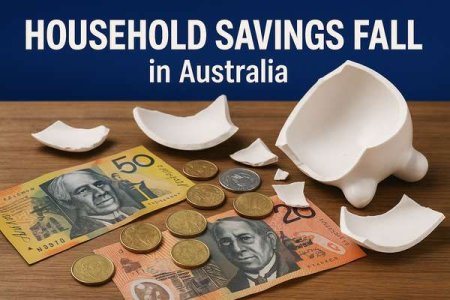Australia’s Vanishing Nest Eggs: The Worrying Sign Hiding in Your Bank Account
- Replies 0
Remember when a visit to the bank was a pleasant errand – perhaps even a chance to see your savings grow? Lately, checking our bank balances feels more like peeking between our fingers during a horror movie. Across the country, Aussies (especially those past 60) are watching our nest eggs shrink, and it’s not just our imagination.
There’s a “very worrying sign” lurking in our bank accounts, as one recent News.com.au article put it, and it speaks volumes about the financial squeeze we’re all feeling.
Finance expert Chris Ford from Compare the Market called it “a sign of the times,” explaining that even though inflation has slowed, “prices don’t necessarily go backwards,” and saving has become “an uphill battle” (Compare the Market).
Back in 2020, things looked very different. Aussies were stuck at home during COVID and couldn't spend much. The household saving ratio shot up to 23.6% of income (ABS Household Income & Savings). Now? It’s plummeted to just 0.9% as of March 2024. That means most people are spending almost all of their income – and some even more than they earn.
Meanwhile, those same interest rate hikes are trickling through to rent, grocery costs, and services. Even if you’re mortgage-free, you’re not immune. The Reserve Bank’s actions have wide-reaching effects.
Sure, mortgage-free retirees have been shielded from some of the worst, but bills still need paying. Not every older Australian owns a home, either – a growing number rent in retirement or still have mortgage debt. They're especially vulnerable to rate hikes and rising rents.
A National Seniors Australia & Challenger study found:
Why? Well, older Australians are more likely to:
So yes, some seniors are enjoying holidays and dinners out. But many are swapping steak for mince, skipping outings, or saying “no” to holidays because their budget just won’t stretch.
Experts like UNSW finance professor Peter Swan have warned that we’re living with a false sense of security – with households quietly running out of money even if the national economy looks “OK” on paper (SMH Analysis).
Finder’s Graham Cooke put it bluntly: when people don’t have savings, they’re “much more likely to have to turn to credit cards, loans, and buy-now-pay-later products to get by”. And that’s how short-term hardship turns into long-term debt.
Government relief measures – like the $300 energy rebate, rent assistance increases, or changes to tax thresholds – are helpful, but temporary. As cost pressures continue, one-off payments can only go so far. There’s growing pressure on policymakers to revisit pension adequacy, super rules, and housing affordability.
And yes, some retirees are embracing their “last chapter” – spending while they can, enjoying experiences, and helping the next generation.
But the deeper question remains: if savings are drying up and financial buffers are gone, what happens when the next crisis comes knocking?
So what do you think? How can we build a retirement system – and economy – where seniors aren’t forced to watch their bank accounts drain just to stay afloat?
There’s a “very worrying sign” lurking in our bank accounts, as one recent News.com.au article put it, and it speaks volumes about the financial squeeze we’re all feeling.
The Hidden Warning in Our Bank Balances
If you’ve noticed your savings account looking a bit scrawnier than it used to, you’re far from alone. New data shows that almost half of Australians have less than $1,000 in savings, and around one in five have nothing at all in the bank (Finder, April 2024). That’s millions of people with barely enough for an emergency. The average balance among those with under $1,000 saved? A sobering $210.Finance expert Chris Ford from Compare the Market called it “a sign of the times,” explaining that even though inflation has slowed, “prices don’t necessarily go backwards,” and saving has become “an uphill battle” (Compare the Market).
A Cost of Living Storm
What’s eating our savings? It’s a cost-of-living crisis chewing through household budgets:- Groceries: The price of eggs jumped 11%, fruit and veg 6%, and lamb 17% over the last year (ABS CPI Data).
- Utilities: Power prices are forecast to rise again from 1 July 2025, once the government’s $300 rebate ends (ABC News).
- Housing & Fuel: Renters face soaring prices, and while petrol fluctuates, it's still punching holes in our wallets.
Back in 2020, things looked very different. Aussies were stuck at home during COVID and couldn't spend much. The household saving ratio shot up to 23.6% of income (ABS Household Income & Savings). Now? It’s plummeted to just 0.9% as of March 2024. That means most people are spending almost all of their income – and some even more than they earn.
Interest Rates Up, Savings Down?
Retirees were told rising interest rates might help them – finally, a return on savings! Some banks now offer 4–5% on certain accounts (Finder comparison). But here’s the kicker: you need savings to earn interest. And with 4.2 million Australians having no savings at all, most people aren’t seeing much benefit.Meanwhile, those same interest rate hikes are trickling through to rent, grocery costs, and services. Even if you’re mortgage-free, you’re not immune. The Reserve Bank’s actions have wide-reaching effects.
Sure, mortgage-free retirees have been shielded from some of the worst, but bills still need paying. Not every older Australian owns a home, either – a growing number rent in retirement or still have mortgage debt. They're especially vulnerable to rate hikes and rising rents.
Retirement Income Reality Check
Let’s talk pensions. The full Age Pension pays around $29,800 for singles and $44,900 for couples per year (Services Australia). Is it enough? Not really.A National Seniors Australia & Challenger study found:
- Only 1 in 4 retirees feel they can live comfortably on the pension alone.
- Most say they need $200–300 extra per week to make ends meet.
- 60% are worried they won’t be able to afford aged care when the time comes.
Spending Patterns: Boom or Bust?
Here’s a twist. According to CommBank iQ, over-70s increased their spending by 7.7% year-on-year, while younger Aussies cut back.Why? Well, older Australians are more likely to:
- Own their homes.
- Have stable income streams (pension, super).
- Spoil the grandkids!
So yes, some seniors are enjoying holidays and dinners out. But many are swapping steak for mince, skipping outings, or saying “no” to holidays because their budget just won’t stretch.
The Safety Net Is Fraying
The dwindling bank balances of older Australians aren’t just a blip. They’re a symptom of a deeper problem: financial insecurity is growing, and it’s creeping into retirement.Experts like UNSW finance professor Peter Swan have warned that we’re living with a false sense of security – with households quietly running out of money even if the national economy looks “OK” on paper (SMH Analysis).
Finder’s Graham Cooke put it bluntly: when people don’t have savings, they’re “much more likely to have to turn to credit cards, loans, and buy-now-pay-later products to get by”. And that’s how short-term hardship turns into long-term debt.
Government relief measures – like the $300 energy rebate, rent assistance increases, or changes to tax thresholds – are helpful, but temporary. As cost pressures continue, one-off payments can only go so far. There’s growing pressure on policymakers to revisit pension adequacy, super rules, and housing affordability.
Silver Linings?
It’s not all doom and gloom. Many older Australians have decades of budgeting wisdom. They know how to stretch a dollar, grow a veggie patch, and make do. Community groups and charities are stepping up with cost-of-living support. Families are banding together.And yes, some retirees are embracing their “last chapter” – spending while they can, enjoying experiences, and helping the next generation.
But the deeper question remains: if savings are drying up and financial buffers are gone, what happens when the next crisis comes knocking?
Over to You
Australia’s seniors have seen it all – high inflation, sky-high interest rates, global shocks. We’ve weathered many storms. But the current squeeze on our savings is a wake-up call. It’s not just about budgeting better – it’s about fixing the system that’s left so many older Aussies running on empty.So what do you think? How can we build a retirement system – and economy – where seniors aren’t forced to watch their bank accounts drain just to stay afloat?









